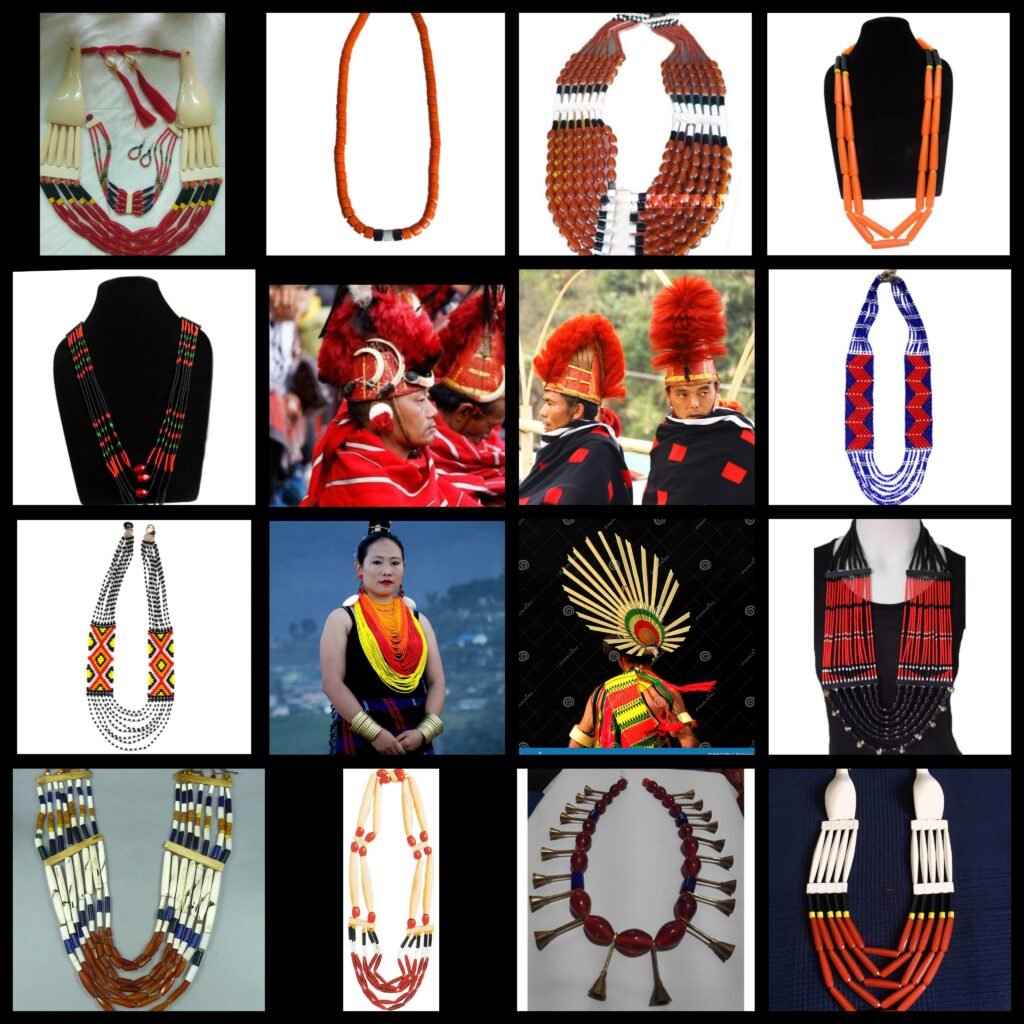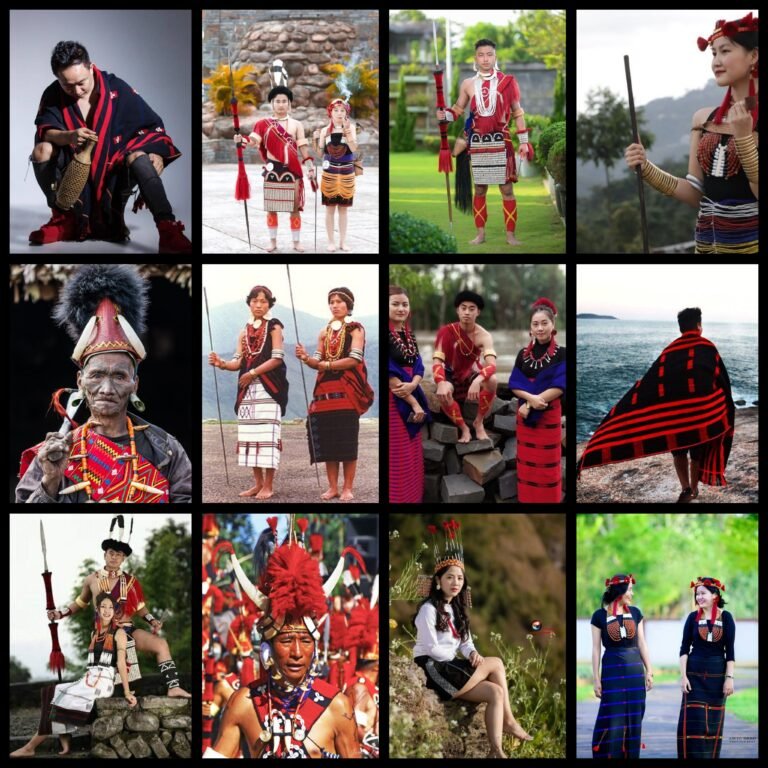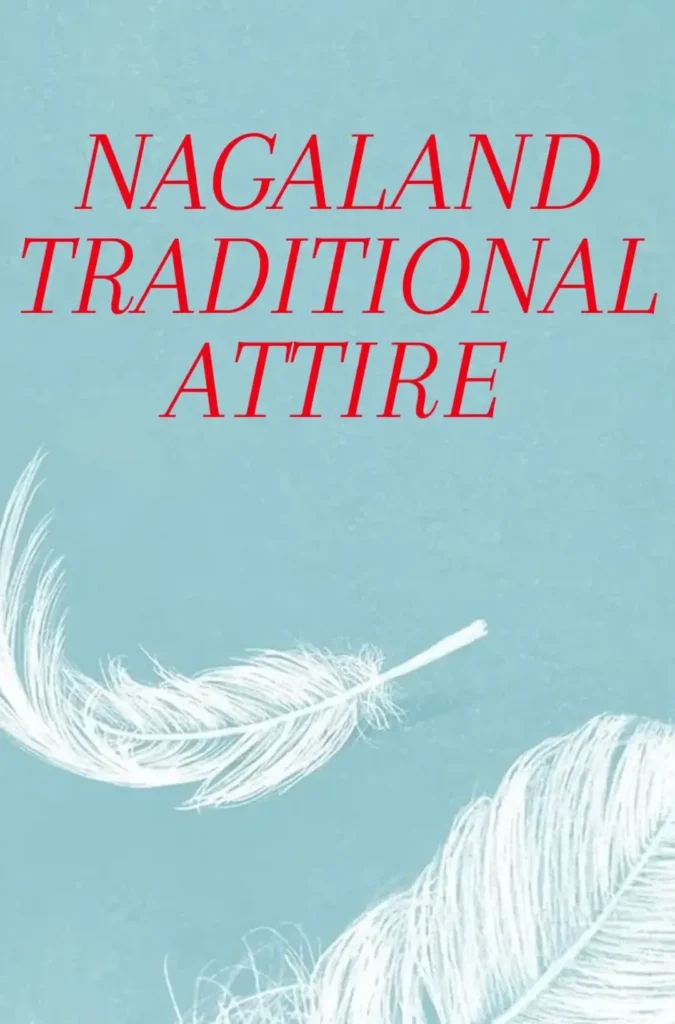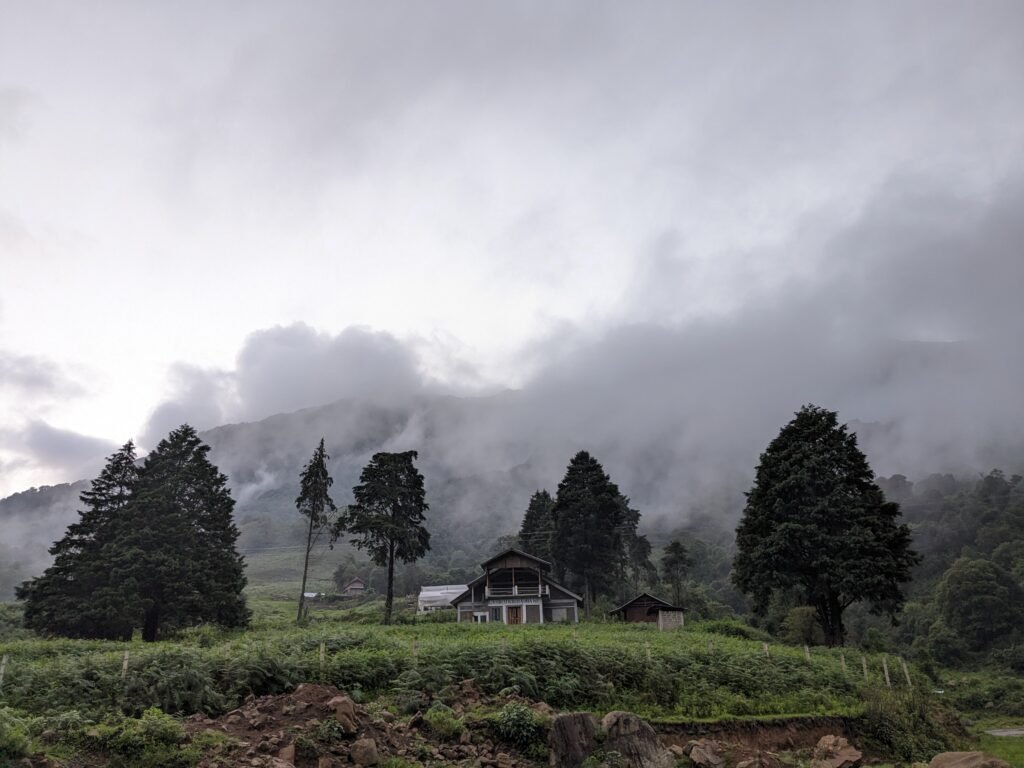Naga Traditional Attire: An Enthralling and Rich Cultural Heritage of Nagaland
Nagaland, a scenic state settled in the northeastern region of India, is distinguished for its dynamic and vibrant cultural diversity. The state is home to several indigenous tribes, each with its unique traditions and heritage. One of the captivating aspects of Nagaland’s cultural identity is its traditional attire, which showcases the creativity, craftsmanship, and symbolism deeply rooted in the Naga society. Here we will explore the rich tapestry of Nagaland’s traditional attire, shedding light on its historical significance, the diversity of styles across tribes, and the materials and techniques employed in their creation.
Comprising various tribes, Nagas have distinct and vibrant traditional costumes that reflect their identity, social status, and cultural practices. Naga traditional attire is an integral part of the rich cultural heritage of the Naga people. The history of Nagaland’s traditional attire dates back centuries and is entwined with the social fabric of its tribes. Clothing played a pivotal role in expressing identity, marital status, social standing, and cultural affiliations. In ancient times, the Naga people used organic materials such as leaves, barks, and animal skins for their attire. These traditional attires are adorned during festivals, ceremonies, and other significant occasions, symbolizing pride, unity, and the preservation of their ancestral traditions. As civilization progressed, they began weaving fabric using indigenous techniques and natural dyes derived from plants and minerals.
The Naga traditional attire showcases a splendid array of colors, intricate designs, and exquisite craftsmanship. Each tribe has its unique style, patterns, and motifs, making their costumes distinct from one another. The attire is often handmade, using traditional weaving techniques passed down through generations, and involves an elaborate process of sourcing raw materials, dyeing, spinning, and weaving.
For men, the traditional attire typically includes a loincloth, locally known as “lohe,” which is a rectangular piece of woven fabric wrapped around the waist and secured with a belt or knot. Men also wear sleeveless or short-sleeved jackets, adorned with intricate beadwork or embroidery. These jackets are often embellished with shells, feathers, and animal teeth, symbolizing the warrior spirit and prowess of the wearer.
Women’s traditional attire is equally captivating and diverse. The key component is a wraparound skirt, called “mekhela,” made from finely woven fabric. The mekhela is usually accompanied by a blouse or a sleeveless top, which can be plain or embellished with decorative elements like beads, shells, and cowrie shells. Women also wear necklaces, bracelets, and earrings made from beads, shells, and metals, enhancing their overall traditional ensemble.
Headgear holds significant importance in Naga culture, representing the identity and social status of individuals. Men often wear distinctive headgears, such as hornbill feathers, boar tusks, or intricately carved wooden crowns. These headgears are adorned with feathers, animal hair, and decorative elements, making them visually striking and culturally significant. Women, on the other hand, style their hair in intricate braids, often decorated with colorful beads and flowers.
Naga traditional attire is not just limited to clothing; it extends to the adornment of accessories and ornaments. Both men and women wear necklaces, bracelets, and earrings made from a wide range of materials, including shells, bones, animal teeth, and metal. These accessories not only enhance their appearance but also signify cultural beliefs, social status, and ancestral connections.

Let us delve into some of the prominent tribal attires found in the region:
1. The Angami tribe is one of the major Naga tribes and is known for their colorful traditional attire. The men wear a sleeveless coat called “Vachü” made of handwoven cotton, adorned with intricate designs. They also wear a white or black shawl called “Lohe” and a headdress made of bamboo and feathers. Women traditionally wear a handwoven cotton skirt called “Pfütsa” along with a shawl called “Vivü.”
2. The Ao tribe has a unique traditional attire. The men wear a sleeveless black or dark blue coat called “Lichü” made of cotton, with embroidered patterns. They pair it with a white skirt called “Chumben” and a headgear made of a twisted cane and adorned with colorful feathers. Women wear a skirt called “Mhoushu” along with a blouse called “Sübkharu,” both decorated with intricate designs.
3. The Konyak tribe is known for their elaborate traditional attire, which is considered one of the most striking in Nagaland. Men wear a handwoven black cotton cloth called “Lo,” draped around their waist and reaching the ankles. They also wear a headdress made of wild boar tusks, feathers, and animal hair. Women wear a black cotton skirt called “Pheikhro” with a red stripe and a shawl called “Kongyei” adorned with beads and cowrie shells.
4. The Sumi tribe has a distinctive traditional attire. Men wear a sleeveless black or dark blue jacket called “Kukhü” made of cotton, with red and white patterns. They pair it with a white loincloth called “Vilhü” and a headgear adorned with feathers. Women wear a skirt called “Pumeku” made of black and red striped cloth, along with a white blouse called “Mekhala.”
5. The Rengma tribe has a simple yet elegant traditional attire. Men traditionally wear a sleeveless coat called “Kho” made of handwoven cotton, with geometric designs. They pair it with a white skirt called “Lothu” and a headgear made of bamboo. Women wear a colorful wrap-around skirt called “Naga Keba” along with a blouse called “Aze.”
6. The Chang tribe, one of the major Naga tribes in Nagaland, has a rich cultural heritage reflected in their traditional attire. The men traditionally wear a sleeveless black and red striped cotton shawl called “Pakhorüm,” which is draped over the shoulder and fastened at the waist with a belt. They pair it with a white or black loincloth known as “Sutam,” reaching the knee. Women wear a colorful wraparound skirt called “Pani,” intricately woven with vibrant patterns and adorned with decorative beads. They also wear a blouse called “Rongkhim” and accessorize with beaded necklaces, earrings, and headgear.
7. The Khiamniungan tribe, has a captivating traditional attire that represents their cultural heritage. Men typically wear a sleeveless black or blue cotton jacket with intricate embroidery and decorative elements, paired with a loincloth called “Pharak,” adorned with colorful patterns. They also wear silver bracelets, armlets, and necklaces. Women don a graceful wraparound skirt called “Pudong,” intricately woven with vibrant designs and adorned with beads and shells. A matching blouse known as “Dungshu” completes their attire.
8. The Chakhesang tribe, boasts a captivating traditional attire that embodies their rich cultural heritage. Men traditionally wear a sleeveless black or white coat called “Chakhu,” adorned with vibrant embroidery and decorative motifs. They pair it with a knee-length wraparound cloth known as “Lohe,” intricately woven with colorful patterns. Additionally, men don headgear like the “Kongsang” or “Mesunyu” made from cane or bamboo. Women don a vibrant “Pfemhou” wraparound skirt, intricately woven with geometric designs and adorned with shells and beads. They pair it with a matching blouse called “Punji” and accessorize with beaded necklaces and earrings.
9. The Kuki tribe, has a distinct traditional attire that reflects their rich cultural heritage. Men traditionally wear a white or black loincloth called “Phawndui,” adorned with colorful stripes or geometric patterns. They pair it with a waistcoat known as “Kawrchei” and a shawl called “Puanchei” draped over the shoulder. Women don a vibrant wraparound skirt called “Puan,” intricately woven with bold motifs and accompanied by a blouse called “Vakiruak.” They accessorize with beaded necklaces, earrings, and headgear adorned with feathers or flowers.
10. The Kachari tribe possesses a captivating traditional attire that reflects their rich cultural heritage. Men typically wear a garment known as “Cheleng” or “Chadara,” a wraparound cloth made of silk or cotton. It is intricately woven with vibrant designs and patterns. They pair it with a shirt called “Kurta” and a waistcoat called “Kurup.” Women adorn themselves in a traditional ensemble consisting of a silk or cotton blouse called “Chadarong” and a beautiful wraparound skirt called “Soka” or “Rigwnai.” They complement their attire with colorful scarves, jewelry, and ornate headgear. The traditional attire of the Kachari tribe signifies their artistic finesse and cultural pride.
11. The Lotha tribe, has a traditional attire that reflects their rich cultural heritage. Men traditionally wear a sleeveless cotton jacket called “Vanghu,” adorned with vibrant colors and intricate designs. It is paired with a loincloth known as “Ngulung,” which is skillfully woven with striking patterns. They complement their attire with accessories like beaded necklaces, bracelets, and headgear adorned with feathers. Women don a vibrant wraparound skirt called “Inyung,” featuring geometric designs and bold colors. They pair it with a matching blouse called “Ichung,” embellished with intricate embroidery and beads.
12. The Pochury tribe, has a fascinating traditional attire that reflects their rich cultural heritage. Men typically wear a knee-length black or dark-colored sleeveless coat called “Kukhom” made of thick woven fabric, adorned with intricate embroidery and motifs. They pair it with a white or black loincloth known as “Chu-khel” and accessorize with beaded necklaces and bracelets. Women adorn themselves in a vibrant wraparound skirt called “Yosem,” intricately woven with traditional patterns and embellishments. They also wear a blouse called “Bekhrü” and adorn themselves with colorful beaded jewelry and headgear.
13. The Sangtam tribe, has a captivating traditional attire that reflects their rich cultural heritage. Men typically wear a sleeveless black or dark blue jacket called “Tsungkotepsu” adorned with colorful intricate designs and patterns. They pair it with a white or black loincloth known as “Lamthu” or “Lapdiru.” Women don a vibrant wraparound skirt called “Aoturung” or “Anghorung,” intricately woven with vibrant colors and traditional motifs. They complement their attire with a matching blouse called “Yimchunger.” Both men and women embellish their attire with accessories like beaded necklaces, earrings, and headgear.
14. The Tikhir tribe, also has a distinctive traditional attire that highlights their cultural heritage. Men traditionally wear a sleeveless black or dark-colored coat known as “Thonghup,” intricately embroidered with vibrant motifs and patterns. They pair it with a loincloth called “Lipah” or “Mapah,” tied around the waist. Additionally, men wear beaded necklaces, bracelets, and headgears as part of their adornment. Women adorn themselves in a colorful wraparound skirt called “Yimchunger,” woven with intricate designs and vibrant hues. They complement it with a matching blouse and adornments like beaded necklaces, earrings, and hair accessories.
15. The Zeliang tribe, embraces a captivating traditional attire that epitomizes their cultural heritage. Men traditionally wear a sleeveless black or red cotton jacket with intricate embroidery, known as “Azheto,” along with a loincloth called “Lohe.” The jacket is adorned with beads, shells, and colorful threads, reflecting their skilled craftsmanship. Women don a vibrant and intricately woven wraparound skirt called “Pheijom,” complemented by a blouse known as “Tsumang.” The ensemble is further accentuated with adorned belts, necklaces, and earrings.
16. The Yimkhiung tribe, exhibits a remarkable traditional attire that reflects their distinct cultural identity. Men traditionally wear a sleeveless black or blue jacket known as “Kongkhak,” intricately embroidered with vibrant patterns and adorned with shells, beads, and feathers. They pair it with a loincloth called “Yumsak,” decorated with colorful motifs. Women wear a wraparound skirt called “Lomphim,” woven with intricate designs and complemented by a matching blouse known as “Thimung.” They accessorize with beaded necklaces, earrings, and headgear adorned with feathers and shells.
17. The Phom tribe, possesses a distinct traditional attire that reflects their rich cultural heritage. Men traditionally wear a sleeveless black or blue cotton jacket known as “Lingnyu,” adorned with intricate geometric patterns and adorned with beads. They pair it with a loincloth called “Lipok,” intricately woven with vibrant designs. Additionally, they wear headgear made of bamboo and feather, along with beaded necklaces and armlets. Women don a beautiful wraparound skirt called “Litham,” woven with intricate patterns and vibrant colors, along with a matching blouse called “Lingring.”


The traditional attires of Nagaland are created using a variety of materials and intricate techniques. Organic materials such as cotton, silk, and wool are commonly used. Additionally, artisans employ indigenous techniques like backstrap weaving, loin-loom weaving, and embroidery to craft these garments.
In recent years, modernization and exposure to other cultures have influenced the traditional attire of Nagaland. While traditional clothing is still cherished during festivals, ceremonies, and cultural events, contemporary fashion trends have led to the fusion of traditional and modern styles. This fusion is evident in the use of modern fabrics, such as synthetic materials, and the incorporation of contemporary elements into the designs. However, efforts are being made to preserve and promote the traditional attire through exhibitions, fashion shows, and cultural initiatives.
Nagaland’s traditional attire stands as a testament to the rich cultural heritage of its indigenous tribes. Each tribe’s attire showcases their distinct identity, creativity, and traditional skills. The materials used and the intricate techniques employed in creating these garments contribute to their uniqueness. While modernization has brought changes to Nagaland’s attire, efforts to preserve and celebrate the traditional clothing are crucial for ensuring the legacy and cultural identity of the Naga people. The vibrant tapestry of Nagaland’s traditional attire will continue to fascinate and captivate both locals and visitors alike for generations to come.




